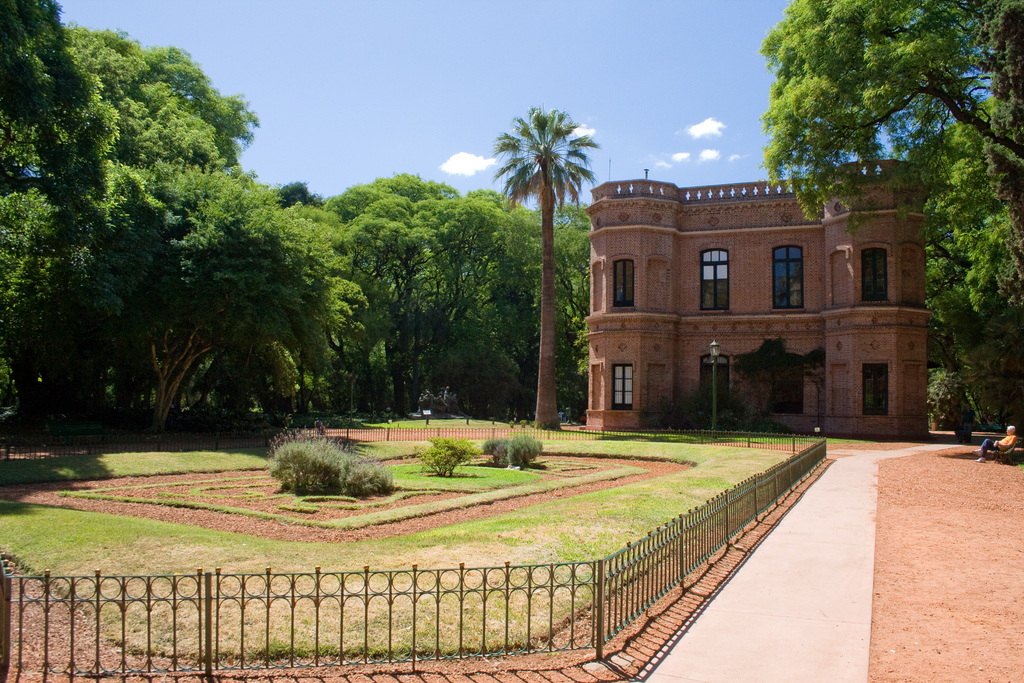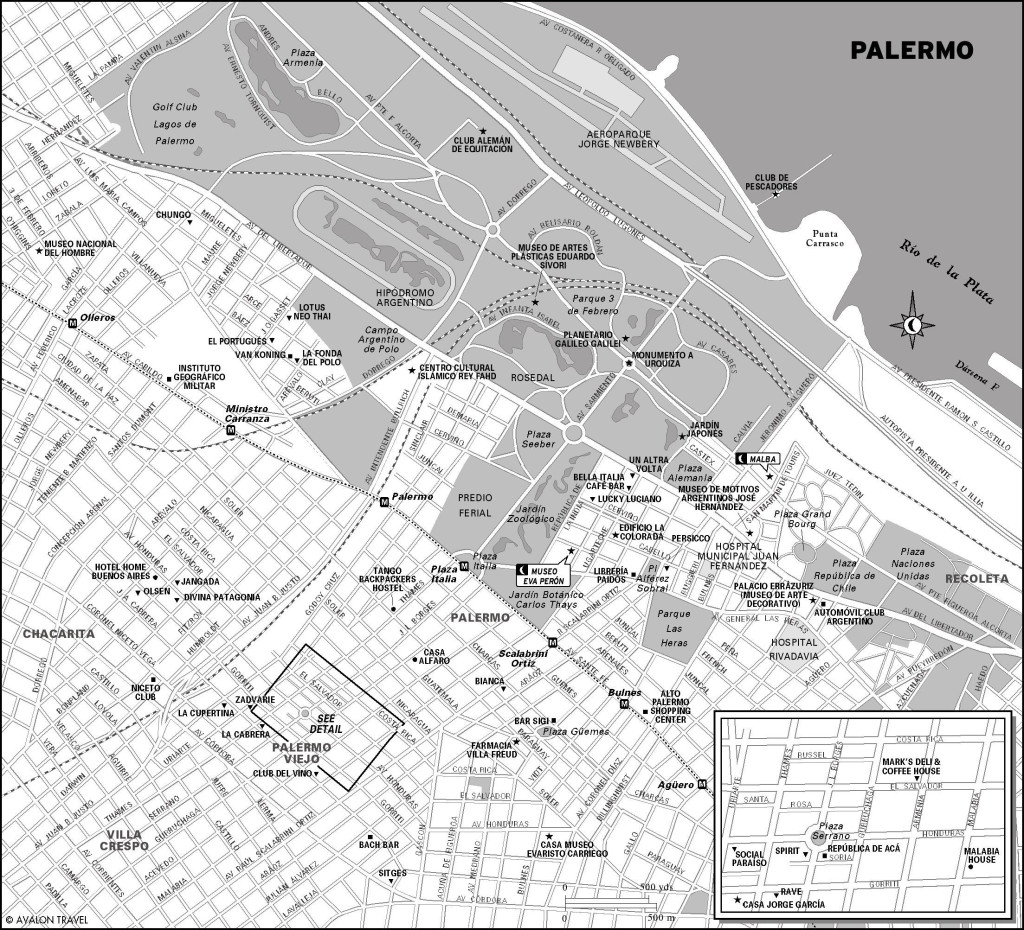Once part of the capital’s unsavory arrabales (margins), its street corners populated by stylish but capricious malevos (bullies) immortalized in Jorge Luis Borges’s stories, Palermo hasn’t entirely superseded that reputation—in some areas, poorly lighted streets still make visitors uneasy. Yet it also has exclusive neighborhoods such as Barrio Parque, also known as Palermo Chico, with embassies, single-family mansions, some of Buenos Aires’s highest property values, and several key museums.
Across Avenida del Libertador, the Botánico is an upper-middle-class enclave taking its name from the Jardín Botánico Carlos Thays (Av. Santa Fe 3951, tel. 011/4831-4527, 8am-6pm daily, free), a lovely botanical garden regrettably infested with feral cats. Once a neighborhood of imposing mansions, the Botánico is still affluent but less exclusive than when, in 1948, Eva Perón enraged the neighbors by making one of those mansions into a home for single mothers; it’s now a museum in her memory.

Palermo’s botanical garden. Photo © Pedro Angelini, licensed Creative Commons Attribution.
Opposite nearby Plaza Italia, the rejuvenated Jardín Zoológico (Av. Las Heras s/n, tel. 011/4806-7412, 10am-6pm Tues.-Sun., US$12, children up to age 12 free) is an ideal outing for visitors with children.
The real action is slightly northwest at Palermo Viejo, where Plaza Serrano (also known as Plaza Cortázar) has become a major axis of Porteño nightlife. Palermo Viejo further subdivides into Palermo Soho and the more northerly Palermo Hollywood, where many TV and radio producers have located facilities. Shaded by sycamores, many streets still contain low-rise casas chorizos (sausage houses) on deep, narrow lots. At the northern end of the barrio, Las Cañitas is a gastronomic and nightlife area challenging Palermo Viejo among partygoers.
Named for the author of the gauchesco epic Martín Fierro, Museo de Arte Popular José Hernández (Av. del Libertador 2373, tel. 011/4803-2384, 1pm-7pm Wed.-Fri., 10am-8pm Sat.-Sun., closed in Feb., US$0.20, free Sun.) specializes in rural Argentiniana. It’s tempting to call it the “museum of irony”: Argentina’s most gaucho-oriented institution stands in one of the country’s most urbane, affluent, and cosmopolitan neighborhoods. Even more ironically, oligarch Félix Bunge built the French-Italianate residence with marble staircases and other lavish features, and exhibits depict gentry like the Martínez de Hoz family—one of whom was the 1976-1983 dictatorship’s economy minister—as symbols of a romantic open-range lifestyle. That said, the museum’s worthwhile collections range from magnificent silverwork and vicuña textiles by contemporary Argentine artisans to pre-Columbian pottery, indigenous crafts, and even a typical pulpería (rural store).
Matías Errázuriz Ortúzar and his widow, Josefina de Alvear de Errázuriz, lived less than 20 years in the ornate Beaux-Arts building (1918) that now houses the national decorative art museum. The inventory of the Museo Nacional de Arte Decorativo (Av. del Libertador 1902, tel. 011/4802-6606, 2pm-7pm Tues.-Sun., closed last week of Dec.-first week of Jan., US$2.50, free Tues.) comprises 4,000 items from the family’s collections, ranging from Roman sculptures to contemporary silverwork, but mostly Asian and European pieces from the 17th-19th centuries. Many items are anonymous; the best-known are by Europeans like Manet and Rodin. Guided English-language tours (US$2.50) are offered Tuesday-Friday at 2:30pm.

Palermo
Dedicated to Latin American art, the Museo de Arte Latinoamericano de Buenos Aires (Av. Figueroa Alcorta 3415, tel. 011/4808-6500, noon-9pm Wed., noon-8pm Thurs.-Mon. and holidays, US$7, US$3 Wed.) is a striking steel-and-glass structure that devotes one entire floor to Argentine businessman and founder Eduardo F. Constantini’s private collections, featuring prominent artists like Mexico’s Frida Kahlo and Diego Rivera. There are also works by Antonio Berni, Chile’s Roberto Matta, Uruguay’s Pedro Figari, and others. The second floor offers special exhibitions. The museum also has a cinema and hosts many events.
Eva Perón, the charismatic spouse of populist president Juan Domingo Perón, made a point of antagonizing her political opponents, or, in her words, “the oligarchy.” At her most combative, to the anger and dismay of neighbors, she chose the upscale Botánico neighborhood for the Hogar de Tránsito No. 2, a shelter for single mothers from the provinces. Even more galling, her Fundación de Ayuda Social María Eva Duarte de Perón took over an imposing three-story mansion to house the transients on their way to the capital.
Since Evita’s 1952 death, middle-class multistory apartment blocks have mostly replaced the elegant single-family houses and distinctive apartments that then housed the Porteño elite (many have moved to exclusive northern suburbs). Fifty years later, on the July 26 anniversary of her death—supporting novelist Tomás Eloy Martínez’s contention that Argentines are “cadaver cultists”—Evita’s great-niece María Carolina Rodríguez officially opened the Museo Eva Perón (Lafinur 2988, tel. 011/4807-0306, 11am-7pm Tues.-Sun., US$4) “to spread the life, work, and ideology of María Eva Duarte de Perón.” What’s missing is a critical perspective. Rather than a balanced account of her life, the museum is a professionally presented chronological homage that sidesteps the demagoguery and personality cults that typified both Evita and her charismatic husband.
There’s a museum store with a selection of Evita souvenirs on site and a fine café-restau- rant as well. Guided English-language tours, bookable in advance, cost US$6.
Excerpted from the Fourth Edition of Moon Patagonia.